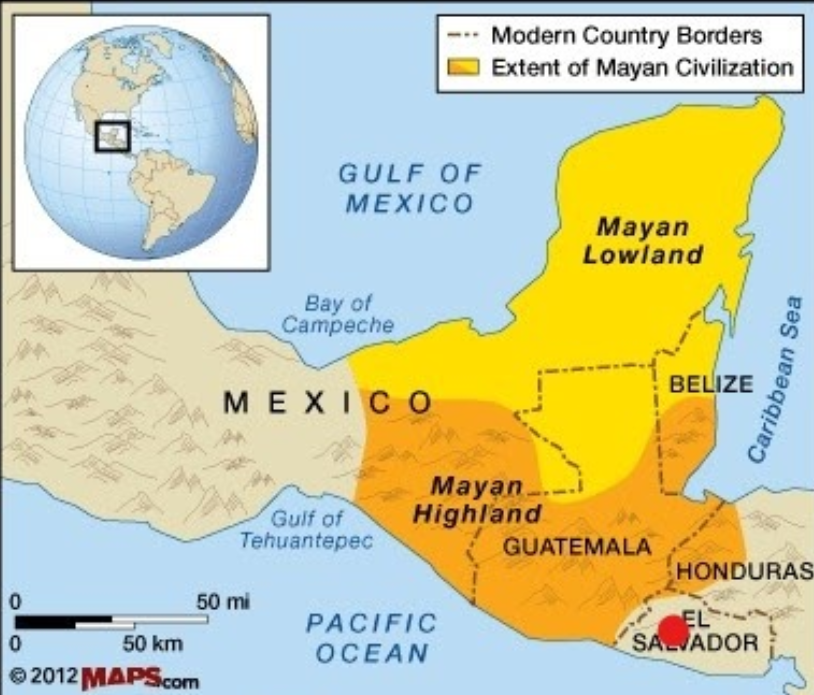What happened?
- Maya civilization, the most advanced society in pre-Colombian America, occupied a large portion of Central America (map below) from c. 2000 BCE until the Spanish conquest in the 16th century. The civilization reached its peak c. 250-900 CE during the so-called Maya Classic Period.
- Researchers have realized that there is a 100 year gap in the civilization’s productivity starting in 540 CE, suggesting a “dark age.” The civilization ultimately survived this, as it did with other temporary collapses in the 2nd and 9th centuries.
- During this “dark age” period, the civilization experienced mass crop failure, which led to disease, starvation and, likely, internal strife. People evacuated cities in and around present-day El Salvador. Many moved to present-day Guatemala in the Maya Highlands, which had thicker, richer soils and more reliable water supply than other Maya regions.
- Cities that were left behind experienced a “dark age” as evidenced by a gap in written records and a sudden decrease in construction in Maya city centers during the 6th century.
- Maya culture shifted from the Early Classic period (c. 250–600 CE) to the Late Classic period (c. 600–900 CE) around this time. The Late Classic period was the height of Maya culture. Cities grew in population and influence, increasing tensions within the city and conflicts with other cities. An influx of people into these cities may have contributed to the conflicts.
How is this related to climate?
- Two massive volcanic eruptions occurred during the 6th century CE, one in 536 CE and one in either 539 or 540 CE.
- Scientists have recently identified Ilopango, a volcano in El Salvador (Central America), as the one that erupted in 539 or 540 CE. Some evidence suggests that El Chichon, a volcano in Mexico (North America), may have also erupted in 540 CE.
- The eruption of Ilopango shot clouds of volcanic ash into the air. This blocked out sunlight, causing an average drop in global temperatures of 2°C (3.6°F), the greatest in 2,000 years.
- The lack of sunlight and drop in temperatures lead to mass crop failure. Droughts, which can also be triggered by volcanic eruptions, may have contributed as well.

Map of Central America with the location of Ilopango marked with a red dot (from National Geographic Society, “Geography in the News: Demise of the Maya” 2012).
Further Exploration
- 40,000 to 80,000 people died in the eruption of Ilopango itself. An additional 100,000 to 400,000 people were affected in its aftermath.
- Evidence for these volcanic eruptions includes written accounts of a dark fog in the sky and volcanic ash particles found in ice cores from Greenland and Antarctica.
- The cooling effects of volcanic eruptions tend to be stronger over land than over water, so the temperature difference between land and water is reduced. These temperature differences drive rainfall and seasonal monsoons, so a reduction in temperature differences may cause droughts.
- The cities that people fled to, such as those in the Maya Highlands, actually benefited because increasing populations provided a larger workforce and army.
References and additional resources
- Dull, R. A., et al. “Radiocarbon and Geologic Evidence Reveal Ilopango Volcano as Source of the Colossal ‘Mystery’ Eruption of 539/40 CE.” Quaternary Science Reviews, vol. 222, 2019. DOI: 10.1016/j.quascirev.2019.07.037.
- Greshko, M. “Colossal volcano behind ‘mystery’ global cooling finally found.” National Geographic. 2019. https://www.nationalgeographic.com/science/2019/08/colossal-volcano-behind-mystery-global-cooling-found/
- Hall, S. “Volcanic Eruption May Have Plunged the Maya into a “Dark Age”.” Scientific American. 2017. https://www.scientificamerican.com/article/volcanic-eruption-may-have-plunged-the-maya-into-a-ldquo-dark-age-rdquo/
- Minster, C. “Timeline of the Maya, From Antiquity to the Present.” ThoughtCo. 2019. www.thoughtco.com/timeline-of-the-ancient-maya-2136181.
- Morton, M. C. “Link between Volcanoes and Drought Cools Geoengineering Prospects.” EARTH Magazine. 2014. https://www.earthmagazine.org/article/link-between-volcanoes-and-drought-cools-geoengineering-prospects.
- Zielinski, S. “Sixth-Century Misery Tied to Not One, But Two, Volcanic Eruptions.” Smithsonian. 2015. www.smithsonianmag.com/science-nature/sixth-century-misery-tied-not-one-two-volcanic-eruptions-180955858/.
